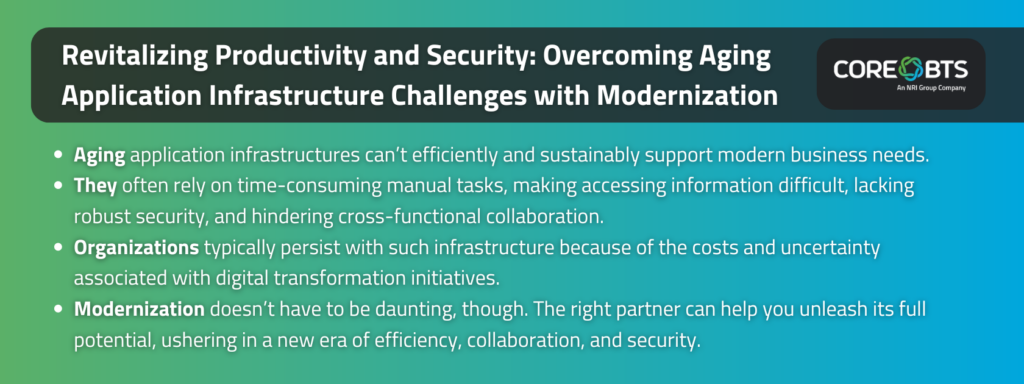
Aging application infrastructure and manual processes are the Achilles heel of today’s digital landscape. They are slow, challenging to maintain, vulnerable to attacks, have poor data accessibility, and are significant roadblocks to innovation.
Yet, many business leaders hang on to them and push back game-changing upgrades because, most of the time, the existing systems are still somewhat functional. The immediate temporal and financial costs and potential disruptions of transitioning to a new infrastructure also make many decision-makers shy away from modernization.
Ironically, relying on an outdated tech stack to avoid modernization costs and business disruptions becomes rather expensive over time. Additionally, there are many significant drawbacks to the “if it’s not broken, don’t fix it” approach. That’s why it’s wise to modernize as soon as possible.
In this article, we delve into the problem of aging application infrastructure and explore the advantages of strategic modernization.
Understanding Aging Application Infrastructure
Aging application infrastructure, or legacy infrastructure, runs critical business operations on outdated hardware and software components and technologies.
Such infrastructure has typically accumulated over many years. While initially implemented to help the business grow, it has reached maturity and does more harm than good. For example, it may hamper development, make integration with innovative technologies difficult, and slow down operations. In other words, it’s hard to support, maintain, and extend due to underlying design and technology limitations.
Legacy infrastructure isn’t solely defined by its age, though. Recently implemented hardware and software components and technologies are legacy if they can’t efficiently and sustainably support modern business needs.
The Problem with Aging Application Infrastructure
Persisting on an outdated tech stack can be problematic in several ways. Some of the drawbacks include:
- Reduced productivity due to time-consuming manual tasks
Legacy infrastructure often heavily relies on manual processes. As a result, employees spend significant time doing mundane, repetitive tasks like entering data, keeping track of paperwork, correcting errors and inconsistencies, and deduplicating data. The opportunity cost is lost productivity as employees could have otherwise spent that time on tasks that maximize their core competencies or in areas where they add the most value to the organization.
- Frustration among employees due to difficulties in accessing necessary informationThis problem results from the underlying design of aging application infrastructures and their dependency on manual processes. Many legacy systems are designed as stand-alone solutions, making integrating them with modern solutions difficult. Over time, this results in data silos, preventing employees from accessing the information they need in real-time. Additionally, an antiquated state of records and workflows means that employees must sort through massive, poorly organized files to find the necessary information. As you can imagine, the chances of missing reports are high. Moreover, it can be incredibly frustrating to aggregate and analyze data when it exists in old file formats, let alone disparate locations.
- Potential security risks associated with outdated technology
With the increasing adoption of machine learning and artificial intelligence in business and technology applications, supporting data-sensitive workloads is paramount. Unfortunately, aging application infrastructures are not designed to handle modern security challenges and high-risk workloads. Legacy systems also have many vulnerabilities and flawed configurations as they don’t receive regular patches or vendor updates. Threat actors have also had enough time to master these vulnerabilities, placing the systems at a high risk of attacks. Additionally, legacy systems lack adequate access control mechanisms, and data is easily exposed to unauthorized personnel, increasing the risk of insider threats.
- Hindered communication and collaboration efforts across different departmentsThe existence of multiple communication channels and siloed data can hinder real-time collaboration across departments, which is crucial in today’s ultra-competitive business landscape. Employees may struggle to get critical messages and data in time, and when they do, they might be missing key pieces of information. This can slow down collaboration efforts, leading to less-than-desirable results.
Despite the many problems it causes, aging application infrastructure is still commonplace in many industries, including healthcare, manufacturing, finance, education, retail, and gaming.
Why Hang on to Legacy Infrastructure?
One recurring reason why organizations persist with aging application infrastructure is familiarity. In other words, some stakeholders are often so accustomed to the existing infrastructure that they would rather preserve the status quo than migrate to a new one – even when it’s counterproductive.
For example, leaders might oppose modernization for fear of losing the significant resources and time invested in maintaining the legacy infrastructure. Or they may be reluctant to finance digital transformation because of its high initial costs.
On their part, employees might resist change because they’re familiar with existing tools and processes and fear learning new technologies might be challenging. Additionally, the fear of losing their jobs can also make them not buy into an infrastructure upgrade.
However, business leaders and employees need not shy away from digital transformation. When appropriately implemented and with the right partner, legacy infrastructure modernization can catalyze productivity and growth.
Modern Application Infrastructure Puts You in Control
Forward-thinking companies embrace digital transformation to stay ahead and in control. You should, too. And it doesn’t have to be daunting, either. With Core BTS as your partner, you can maximize the many benefits of infrastructure modernization, including:
- Increased productivity through automation.
- Improved data access, analysis, and decision-making through digitization, centralization, and organization.
- Better security by leveraging cutting-edge tools and practices.
- More impactful collaboration through efficient communication channels and real-time access to crucial information.
- Flexibility to move resources and scale as needed.
Discover how we modernized aging applications with M365 and ushered in a new era of efficiency and collaboration for the full-service packaging solutions company Green Bay Packaging. Click here to learn more.





Share on